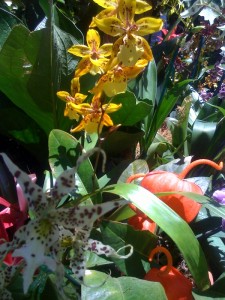I’ve been inspired to write about the qualities of feminine leadership after seeing a wonderful exhibit in San Diego at the Mengei International Museum. It’s entitled Sonabai: A New Way of Seeing. Sonabai was a poor woman who lived in a remote village in central India and was married to a man who kept her imprisoned in their house for ten years. Unable to have contact with anyone but their small son, and able to only go out to their well, Sonabai went beyond surviving to thriving. She began to create.
When she discovered that she could sculpt the thick mud she scraped off the sides of their well, Sonabi began to make figures and animals to serve as toys. Next, it occurred to her to fashion a screen that would filter the hot sun beating down on one side of the house. She tied pieces of bamboo into small circles and connected them. She attached her screen to the house with wood, and covered the whole thing with mud. Next, she sculpted whimsical birds and figures to sit within the openings of the screen. She painted all her work with bright colors made of vegetal dyes. By the end of her decade, her whole house had become a work of art.
Sonabai created something completely unique without any training or any exposure to architecture or art. She had never seen or known about the elaborate screens that are part of the royal architecture in India’s cities. Yet out of the deep well of creative energy to which we all have access, she created outrageous beauty. Other women nearby had decorated their doorways, but in patterns and colors that stayed within the local traditions. Sonabai’s art was fresh, innocent, alive and original. Like the plants in the photo above, the details she chose, the colors and the variety of designs were delicious.
Sonabai wasn’t aware that she was going to become a leader, but she did. When she was discovered and her art was exhibited internationally, she received a grant to teach other Indian artists her methods. They have taken the basic folk art themes and developed their own styles and variations. Sonabai has left a legacy–not only of art, but a lesson about creativity and empowerment.
Perhaps the way we can all engage the creative power that lives within us, is to begin by thinking of what kinds of beauty we love. How can we create more experiences of these kinds of beauty? Some of us might not ever sculpt or paint, but we might create beauty with food or flowers or music or dance. We might recite poetry with passion or learn the forms of a sport in a way that feels beautiful to us. All these efforts are ways in which we can empower ourselves. We can do more than survive; we can thrive.
If you’re curious about Sonabai and the gorgeous exhibit created by anthropologist, photographer and curator, Stephen Huyler, go to http://www.sonabai.com/exhibition.html.
And then, I’d love to hear your comments about how you create beauty and how you feel that is related to the new feminine leadership!

